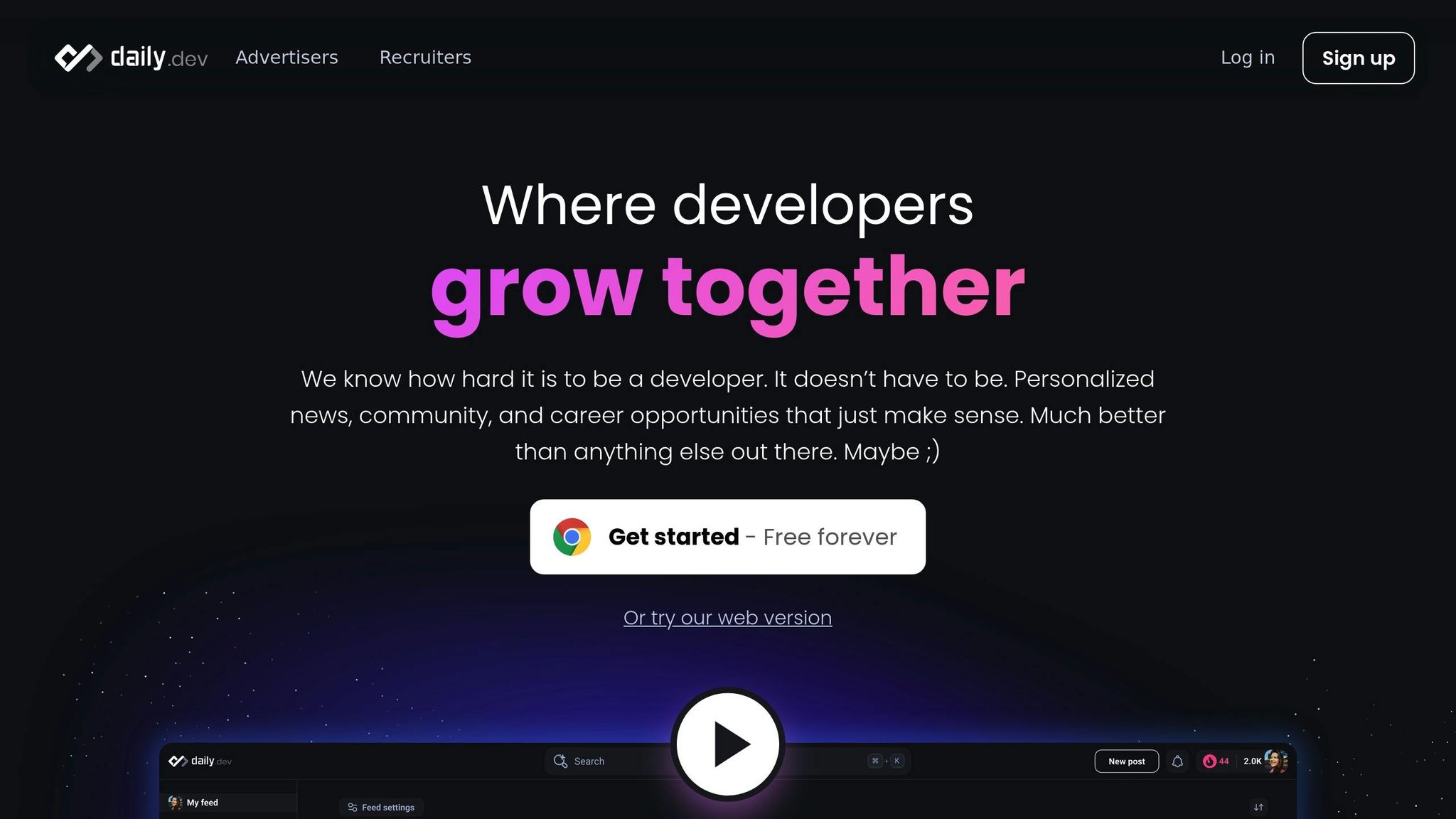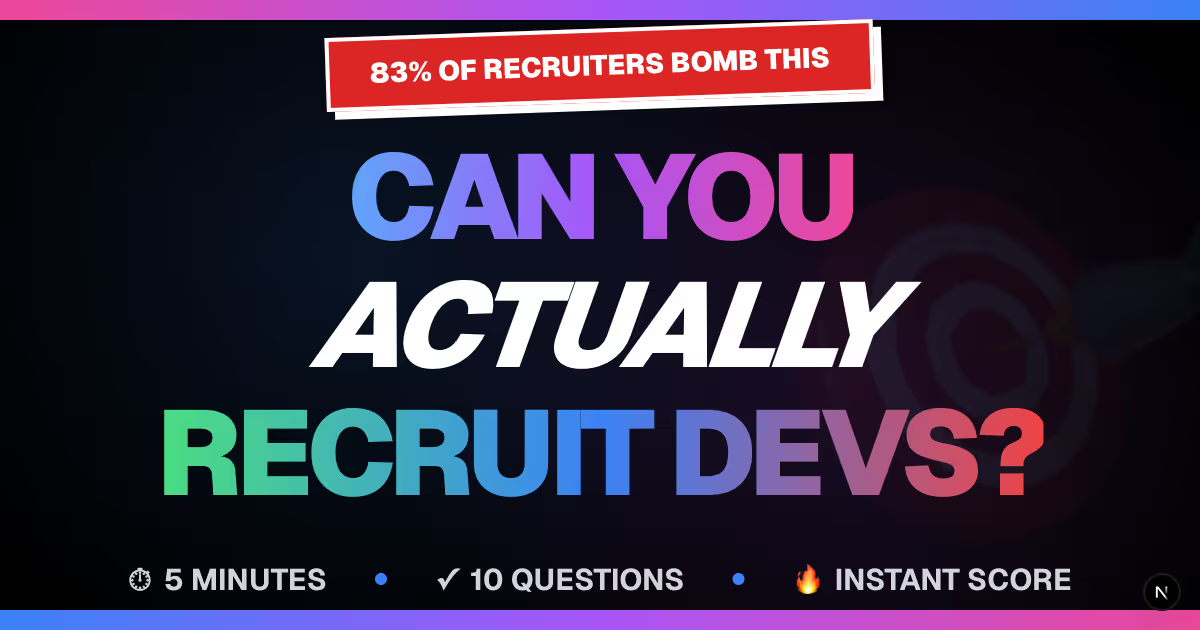


Poorly written job descriptions deter developers. Learn how to create clear, engaging postings that attract top technical talent.
Recruiting developers is tough, and poorly written job descriptions are a big part of the problem. Many companies rely on vague, generic postings that fail to connect with what developers care about. Here’s why most job descriptions fall short:
- Lack of Clarity: Developers avoid roles with unclear responsibilities or buzzwords like "rockstar."
- Overemphasis on Skills: Long lists of qualifications overshadow the actual impact of the role.
- No Transparency: Missing salary and benefits details erode trust.
- Developer Interests Ignored: Postings rarely highlight growth opportunities, tech challenges, or meaningful work.
The result? Fewer applications, higher recruitment costs, and a damaged employer reputation. Developers want clear, transparent, and engaging job descriptions that show how their work will make an impact. Companies need to rethink how they write and present roles to attract top talent effectively.
Common Mistakes in Developer Job Descriptions
Writing job descriptions solely from the company's perspective often misses the mark when it comes to what developers actually care about. This disconnect can discourage talented developers from even considering the role. Here are some common mistakes that tend to drive developers away.
Generic or Vague Role Definitions
One of the biggest frustrations developers face is a lack of clarity about the role. Overloading job postings with buzzwords like "rockstar" or "ninja" doesn't help - it fails to describe the real challenges or systems they'll be working on. According to daily.dev, critical role details "rarely fit in a public job description", leaving developers to guess whether the job aligns with their skills and interests. Without clear expectations, developers are more likely to gravitate toward roles where responsibilities are better defined.
Overemphasis on Qualifications Instead of Impact
Job descriptions that focus too much on qualifications - like "Must have 5+ years of React, 3+ years of Node.js, experience with AWS, Docker, Kubernetes..." - can be a turnoff. While these requirements may seem important, they often overshadow what developers really want to know: the purpose of the role, the challenges they'll tackle, and how their work will make a difference.
When the emphasis is on qualifications, many capable candidates may opt out if they don't meet every single requirement. This is a missed opportunity, as hiring managers are often satisfied with candidates who meet 70–80% of the criteria. Shifting the focus to what the candidate will achieve in the role makes the opportunity far more appealing and relatable.
Lack of Transparency in Salary and Benefits
Another major roadblock is the absence of clear compensation details. When salary ranges, benefits, or flexible work options are left out, it can erode trust right from the start. Developers want to know upfront whether the role meets their expectations. Daily.dev highlights that reply rates for introductions exceed 85–90% when candidates are given full context, including compensation details. Without this transparency, candidates may assume the pay is low or that the company isn't being upfront, which can discourage them from applying.
Ignoring Developer-Specific Interests
Many job descriptions fail to address what really excites developers: growth opportunities, technical challenges, and the chance to work on meaningful projects. Instead, they focus solely on business needs, leaving out details that matter to developers, like:
- Tech stack evolution and the company’s technical roadmap
- Opportunities for mentorship and continuous learning
- Code quality practices, testing methods, and deployment processes
- Levels of autonomy in making technical decisions
Without this context, developers may assume that professional development isn’t a priority or that the role lacks meaningful impact. Additionally, a lack of information about team structure, collaboration styles, and project ownership can leave candidates unsure of how they’d fit into the bigger picture.
As daily.dev Recruiter puts it:
"Screening that captures what job descriptions miss... This ensures every intro is validated not just against the job description, but also your hiring manager's must-haves and other criteria that rarely fit in a public job description."
The Impact of Poor Job Descriptions
Poorly written job descriptions don't just reduce the number of applicants - they can ripple through the entire hiring process, creating challenges at every step. When companies fail to clearly communicate their expectations, the consequences can be significant, affecting application rates, recruitment costs, and even the company's reputation.
Fewer Applications and Misaligned Candidates
When job postings are vague, they tend to drive away qualified developers who are looking for roles with clear expectations and requirements. Without enough detail, experienced professionals may skip over the opportunity entirely, leaving behind a pool of candidates who may not fit the role. This mismatch results in companies receiving applications from individuals who are either overqualified or lack the necessary skills. For example, within the daily.dev network, a staggering 90% of developers won’t engage with unclear job postings elsewhere.
Increased Recruitment Costs and Delayed Hiring
Unclear job descriptions don’t just make it harder to find the right talent - they also make the hiring process more expensive and time-consuming. Recruiters often spend additional time sifting through mismatched applications or conducting extra screening rounds to identify suitable candidates. Generic or poorly written postings may also require broader recruitment efforts, which drive up costs. Meanwhile, the delay in finding the right hire often means that top candidates have already accepted offers elsewhere.
Harm to Employer Brand
In the developer community, reputation matters. Job descriptions that are vague or misleading can quickly tarnish an employer’s image. Developers talk, and word spreads fast when a company fails to provide clear and honest job postings. This erosion of trust can make it even harder to attract top technical talent in the future. According to daily.dev, trust plays a critical role in modern recruiting, and a damaged reputation can have long-term consequences for hiring efforts.
Best Practices for Writing Developer-Friendly Job Descriptions
Creating job descriptions that truly resonate with developers requires more than just listing qualifications. To attract top talent, job postings should provide clear, detailed, and developer-specific information. Think of these descriptions as concise briefs that give developers all the context they need to make informed decisions about their next career move. Here's how to turn generic job posts into engaging, developer-focused opportunities.
Write Specific Job Titles
The job title is often the first thing a candidate notices, so make it count. Avoid generic titles like "Software Engineer" and opt for ones that clearly define the role. For instance, instead of being vague, use titles like "Senior React Developer", "DevOps Engineer – Kubernetes", or "Full-Stack Engineer – Python/Django." These labels immediately communicate the role's focus and help developers determine if it aligns with their expertise.
Focus on Required Skills and Responsibilities
Transparency is key when outlining skills and responsibilities. Developers want to know which skills are non-negotiable and which are nice-to-haves. Start with the core technologies, frameworks, and experience levels that are essential, then list secondary skills that could be useful but aren’t mandatory.
Be specific about what the job entails. Replace generic phrases like "develop software solutions" with clear examples such as "build and maintain scalable REST APIs" or "optimize database queries for high-traffic applications." This level of detail helps candidates quickly assess whether their skills match the role.
Include Salary and Benefits Information
Salary transparency builds trust - a vital element in modern recruiting. As Nimrod Kramer from daily.dev points out:
"Trust is the currency of modern recruiting".
Instead of vague phrases like "competitive compensation", include a specific salary range, such as "$120,000 – $150,000 annually." Highlight benefits that appeal to developers, like stock options, professional development budgets, conference attendance opportunities, and flexible PTO policies. Be upfront about whether the role is fully remote, hybrid, or on-site, and note any geographic restrictions.
Show What Motivates Developers
Job descriptions that go beyond requirements and highlight what makes the role exciting are far more engaging. Developers want to know how their work will make an impact, the technologies they’ll use, and how the position aligns with their skills and career goals. Mention the tech stack, the scale of projects, and any unique challenges the role offers to make it stand out.
Career growth is another major draw. Include details about mentorship opportunities, learning budgets, and advancement paths to show your commitment to their professional development.
Make Job Descriptions Easy to Read
Formatting matters just as much as content. Developers often skim job descriptions, so make the information easy to digest. Use bullet points for technical requirements, bold key details, and structure the description into logical sections - from an overview to responsibilities and benefits. Keep paragraphs short and avoid unnecessary jargon to ensure candidates can quickly find the details they care about.
sbb-itb-d1e6221
How daily.dev Recruiter Solves Developer Recruitment Challenges

Crafting a solid job description is just one part of the hiring puzzle. The real challenge lies in ensuring it reaches the right developers. That’s where daily.dev Recruiter steps in, offering a fresh, developer-focused approach to hiring. By leveraging its active developer network, it addresses the shortcomings of traditional recruitment methods and turns challenges into opportunities for real engagement.
Connect with Passive, Pre-Qualified Developers
The hardest part of recruiting developers isn’t creating better job postings - it’s finding developers who aren’t actively searching for jobs. Surprisingly, 90% of developers ignore traditional recruitment channels. They’re not browsing job boards or responding to cold outreach, but they are engaging on platforms like daily.dev.
daily.dev Recruiter bridges this gap by connecting you with passive candidates - those not actively job hunting - right where they’re already spending their time. With 1 in 50 developers worldwide on the platform, it provides access to a highly engaged community. These developers visit daily.dev regularly to stay informed about the latest tools, technologies, and trends. When job opportunities naturally appear in this trusted environment, developers are more open to exploring them. Plus, every introduction is warm and double opt-in, leading to reply rates as high as 85–90%.
Developer-Friendly Job Briefs and Targeted Visibility
Instead of relying on generic job descriptions, daily.dev Recruiter transforms them into developer-friendly briefs that resonate with its audience. These briefs are carefully reviewed and tailored before they go live. Rather than broadcasting roles to a wide, uninterested audience, the platform discreetly presents opportunities to developers whose skills, interests, and career goals align with the position.
This targeted approach ensures your job listing reaches the right candidates - those who are both qualified and genuinely interested. For instance, a senior React developer seeing a role titled "Senior React Developer – Fintech Scaling Challenges" immediately understands the technical fit and the exciting challenges the job offers. This kind of personalized visibility fosters meaningful interactions, making developers more likely to engage with the opportunity.
Trust-Based and Contextual Recruitment
Trust is often missing from traditional recruiting methods. Spammy messages, vague job descriptions, and bait-and-switch tactics have eroded developers’ confidence in recruiters. daily.dev Recruiter rebuilds that trust by embedding job opportunities within a platform developers already know and value. Roles appear natively within the daily.dev environment, making the experience feel natural and non-intrusive.
Transparency is a key feature. Developers get complete context about each role upfront, allowing them to self-screen before engaging. This saves time by reducing unproductive conversations. Additionally, recruiters can define up to three custom screening questions to capture specific requirements that don’t fit neatly into a public job description. As a result, every conversation becomes more focused and productive, with candidates who already meet your most critical criteria.
Conclusion: Attracting Developers with Better Job Descriptions
Bringing in top developer talent takes more than tossing out generic job listings. Weak job descriptions are costing companies valuable time and money, often pushing away qualified candidates before they even consider applying. The key is understanding what developers care about: clear role expectations, transparent pay, meaningful work, and respect for their expertise. These are the cornerstones of successful developer recruitment.
Steer clear of common mistakes. Cut out unnecessary "nice-to-have" skills that discourage strong candidates. Instead, focus on showcasing the technical challenges and growth opportunities that make the role stand out - not just a laundry list of requirements.
Of course, even the best job description won’t work if it doesn’t reach the right audience. That’s where daily.dev Recruiter changes the game. It connects you directly with engaged, pre-qualified developers. This platform refines your job requirements into concise, targeted messages that land in front of candidates who truly fit what you’re looking for.
A trust-based system beats cold outreach every time. Developers are far more likely to respond to opportunities presented on a platform they already trust and value. This approach leads to meaningful conversations with candidates who are genuinely interested - no more chasing down disinterested leads or wasting time on screening calls that go nowhere. With this method, you’re not just filling roles; you’re building lasting connections with talent.
Recruiting developers isn’t just about speeding up the hiring process. It’s about fostering relationships with the developer community and positioning your company as an employer that “gets it.” By addressing what developers truly value and pairing thoughtful job descriptions with the right platform, you gain a real edge in attracting and retaining top talent.
FAQs
How can I write job descriptions that attract developers?
When writing job descriptions that connect with developers, aim for clarity, honesty, and relevance. Start by clearly defining the role's purpose, main responsibilities, and the skills required - skip the buzzwords and unnecessary jargon. Developers value straightforwardness, so make sure to include practical details like salary ranges, the tech stack they'll work with, and insights into the work environment.
It’s also worth emphasizing how the role offers opportunities for professional growth and contributes to meaningful projects. Instead of using vague terms like "rockstar developer", focus on describing the actual impact the role will have. And above all, keep the description concise and well-organized - developers are more likely to engage with a job post that's easy to read and gets straight to the point.
How can companies create transparent job postings to build trust with developers?
To earn trust from developers, companies need to prioritize clear and straightforward communication in their job postings. Be specific about the role by detailing responsibilities, required skills, salary range, and the work environment. Steer clear of vague terms or overused buzzwords that might confuse or mislead potential candidates.
Equally important is ensuring the hiring process matches the expectations set in the job description. Evaluate candidates based on the outlined criteria and keep them informed with timely, transparent updates. Developers appreciate honesty, so being upfront about the role and how the company operates is essential for building a genuine connection.
Why should developer job descriptions emphasize the role's impact instead of just listing qualifications?
When you highlight how the role makes a difference, it helps developers see the value of their work and how it ties into achieving meaningful results. This approach makes the position more appealing and easier to connect with, especially for those who want their efforts to matter.
On the other hand, centering the conversation only on qualifications can come across as cold and purely transactional. Shifting the focus to the role’s purpose and broader objectives can attract candidates who are driven by creativity and a sense of mission, rather than just ticking off a list of required skills.
Related Blog Posts








